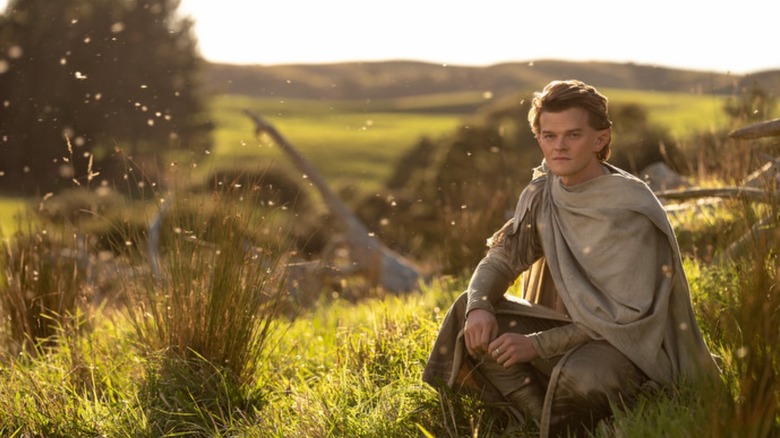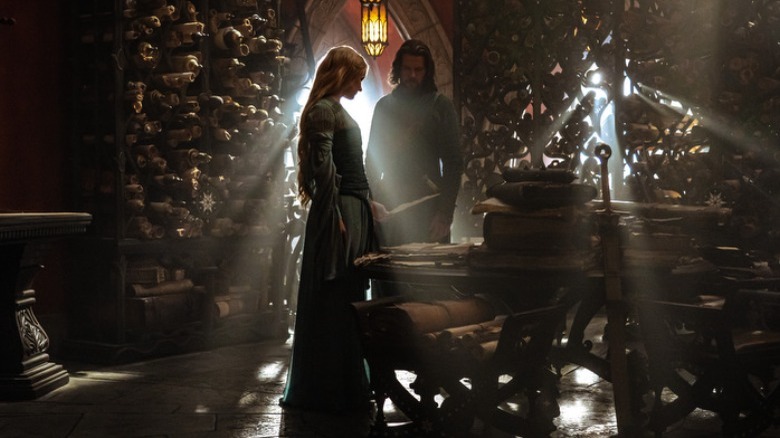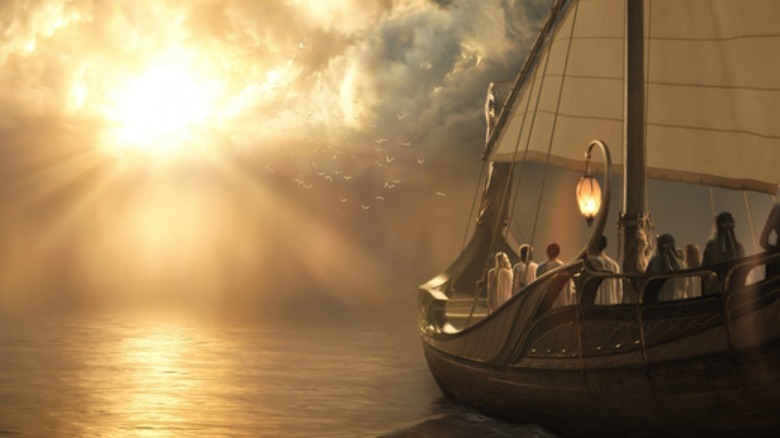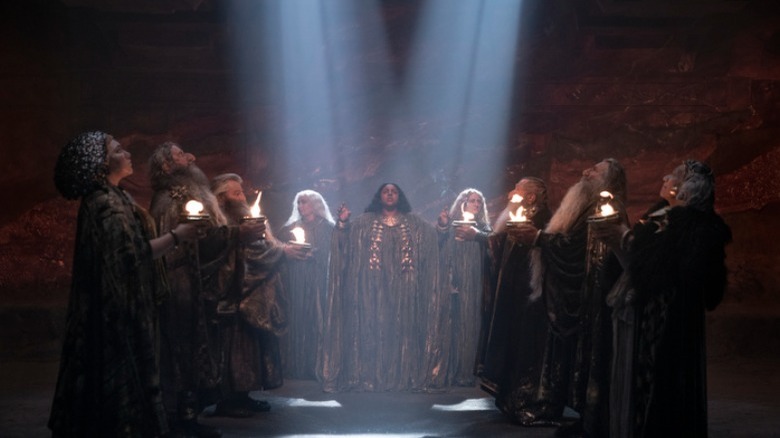The Rings Of Power Is The Antithesis To The Literally Dark Fantasy Show
"The Lord of the Rings: The Rings of Power" is breathtaking. The new "Lord of the Rings" prequel series is reportedly the most expensive TV show ever made, so it would be weird if it didn't look good, but when I watched the first two episodes on a big, bright screen, I was blown away by its dazzling visuals. It's a series that not only has an inordinate amount of money to work with, but that clearly uses it well, as it already feels transportive and epic in a way that puts most other fantasy shows to shame.
It also has a simple secret weapon that's hidden in plain sight, one that's vanishingly rare these days: light. The series often bathes its characters in light, from the celestial glow of Valinor to the very first scene, in which a young Galadriel builds a swan-shaped paper boat and sets it afloat in a stream. Everything about this prologue sets the tone for the series, telling us that the Middle-earth of the series will be ethereal and lush — part of a flourishing golden age. It also bucks an increasingly common trend that's left TV fans and moviegoers literally in the dark.
When screens go dark
The trend of dark TV and film has been on the rise for years, with 2019's Battle of Winterfell episode of "Game of Thrones" serving as a much-discussed example of a viewing experience that can suffer due to lighting decisions. For all the pushback against that episode, dark TV isn't the end of the world, and there's often a TV settings workaround — like the one described by Neil Miller in a recent episode of The Ringer's "Trial By Content" podcast – to make filmmakers' artistry visible even in the darkest of scenes.
Yet it's still a rare delight to see a large-scale fantasy show as vibrant and bright as "The Rings of Power." The dark cinema trend seems to go far beyond "Game of Thrones" at this point. Studio blockbusters are washed out and poorly color graded, films like moody neo-noir "The Batman" use a nearly all-black color palette, and even first-look images like those from the highly anticipated new "Hellraiser" film are shrouded in so much shadow that it's tough to see what's going on.
Genre TV shows haven't avoided the trend either. Aside from "Game of Thrones, "The Handmaid's Tale," "The Walking Dead," and Apple TV's "Servant" and "Invasion" are just a few of the many sci-fi, horror, and fantasy series that sometimes lose something in translation thanks to uber-dark scenes that push the limits of our TV settings.
Dark TV isn't always a bad thing
There are several reasons a production could choose to go dark. In an era that sees filmmakers scramble to make TV shows they can call "one long movie," striking visuals are one way to accomplish that impression. Visual darkness has long-since been associated with seriousness, and in a post-prestige TV world, many small-screen series seem to be in a perpetual race to be taken the most seriously. There's also a more gracious read of the same inclination: perhaps we're simply entering a new phase of neo-noir, in which the cultural breakdown of trust in the world around us translates (both purposefully and subconsciously) to a literal, palpable sense of darkness in visual art.
Finally, there are the practical concerns. As an executive producer told TVLine in a 2018 investigation of dark TV, when it comes to shows with lots of CGI, "it could also be a showrunner trying to hide sins." Shoddy effects work can be camouflaged with lighting and color changes. Yet "Lord of the Rings: The Rings of Power" so far doesn't seem to have many visual effects sins to hide. The show looks gorgeous, and not only keeps its world far lighter than most of its contemporaries, but also uses lighting as a noticeable, integral visual element.
The artistry of Rings of Power's lighting design
It's not enough to say that light just exists in this world: it bathes, it illuminates, it glows. It's not meant to look earthlike, but enchantingly otherworldly. There's a reason the light in the show looks so good: much of its technical direction is credited to Wētā FX, the New Zealand effects company that was co-founded by acclaimed original trilogy filmmaker Peter Jackson. Famed effects company Industrial Light and Magic also worked on the series. Even in night-set scenes, as when the harfoot kids discover a man who fell from the sky, or Arondir (Ismael Cruz Córdova) explores an underground tunnel, the show still utilizes the warm glow of flames and other light sources — almost certainly enhanced or created by subtle effects — to keep its scenes aglow.
Ultimately, the literal light of "Lord of the Rings: The Rings of Power" communicates a playfulness and sense of magic that sets it apart from many of its edgy genre peers. If other fantasy worlds are inspired by the chiaroscuro designs that led to film noir, this one seems to pull more from the aesthetics of the Age of Enlightenment, when light was as much a subject in visual art as it was a tool. The show isn't pulling out all the stops to sell us on a vision of a twisted, violent, pitch-black world, but on a heavenly one that's so bright that it's hard for most of its characters to see the evil lurking at its edges.
Hopefully, when metaphorical darkness does eventually come to Middle-earth's Second Age, the show won't forfeit its refreshing and lively lighting design in the process.



